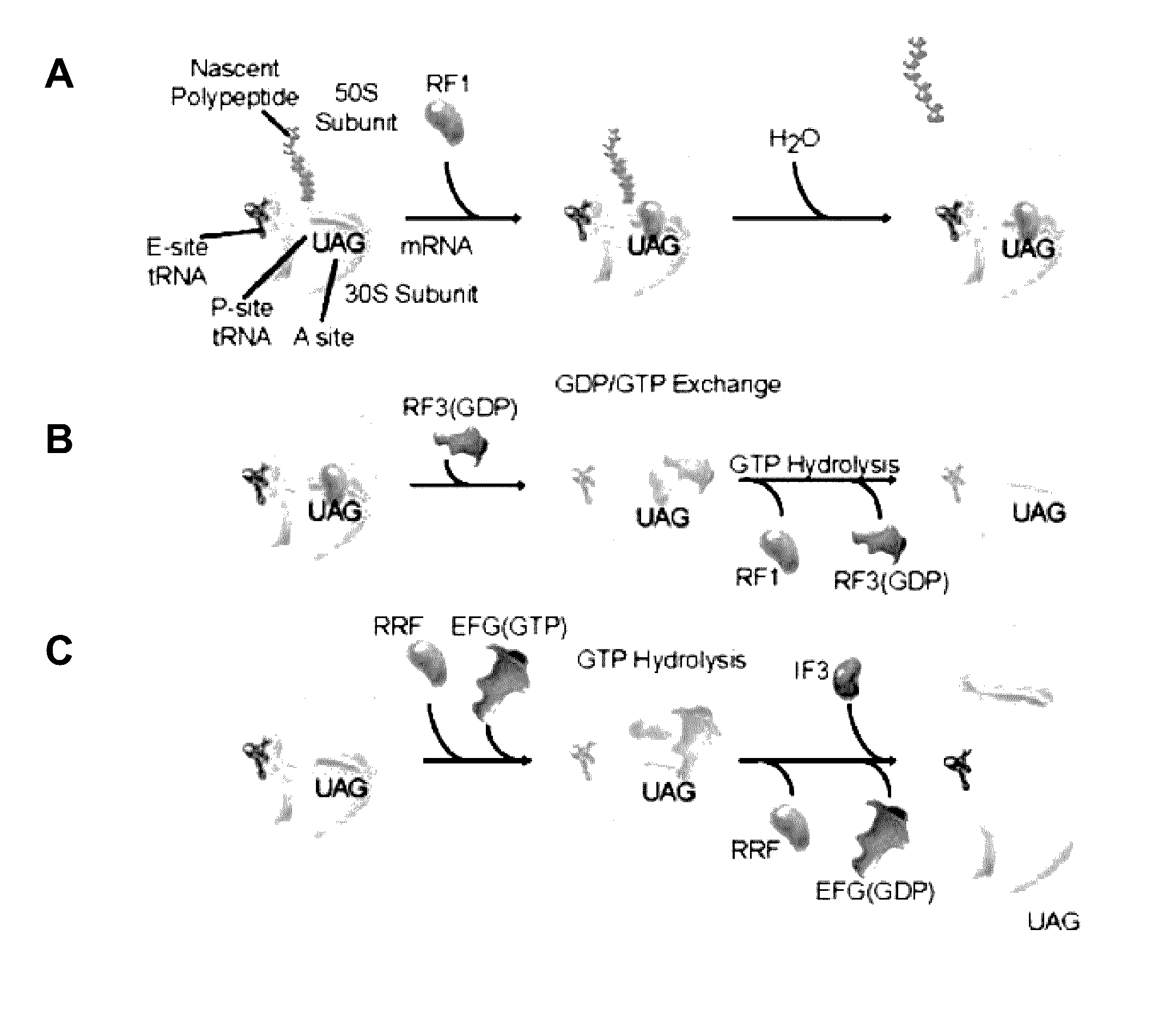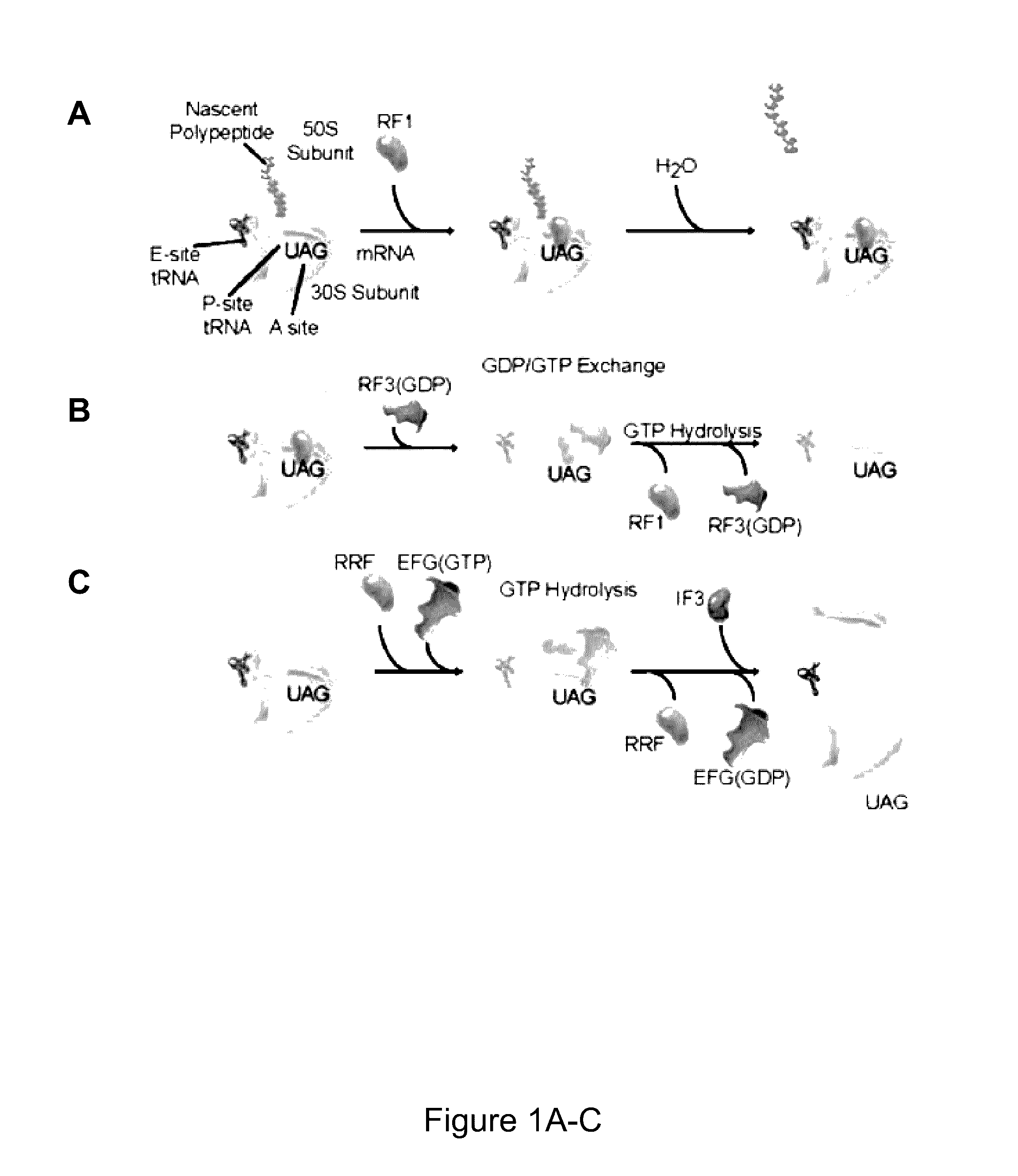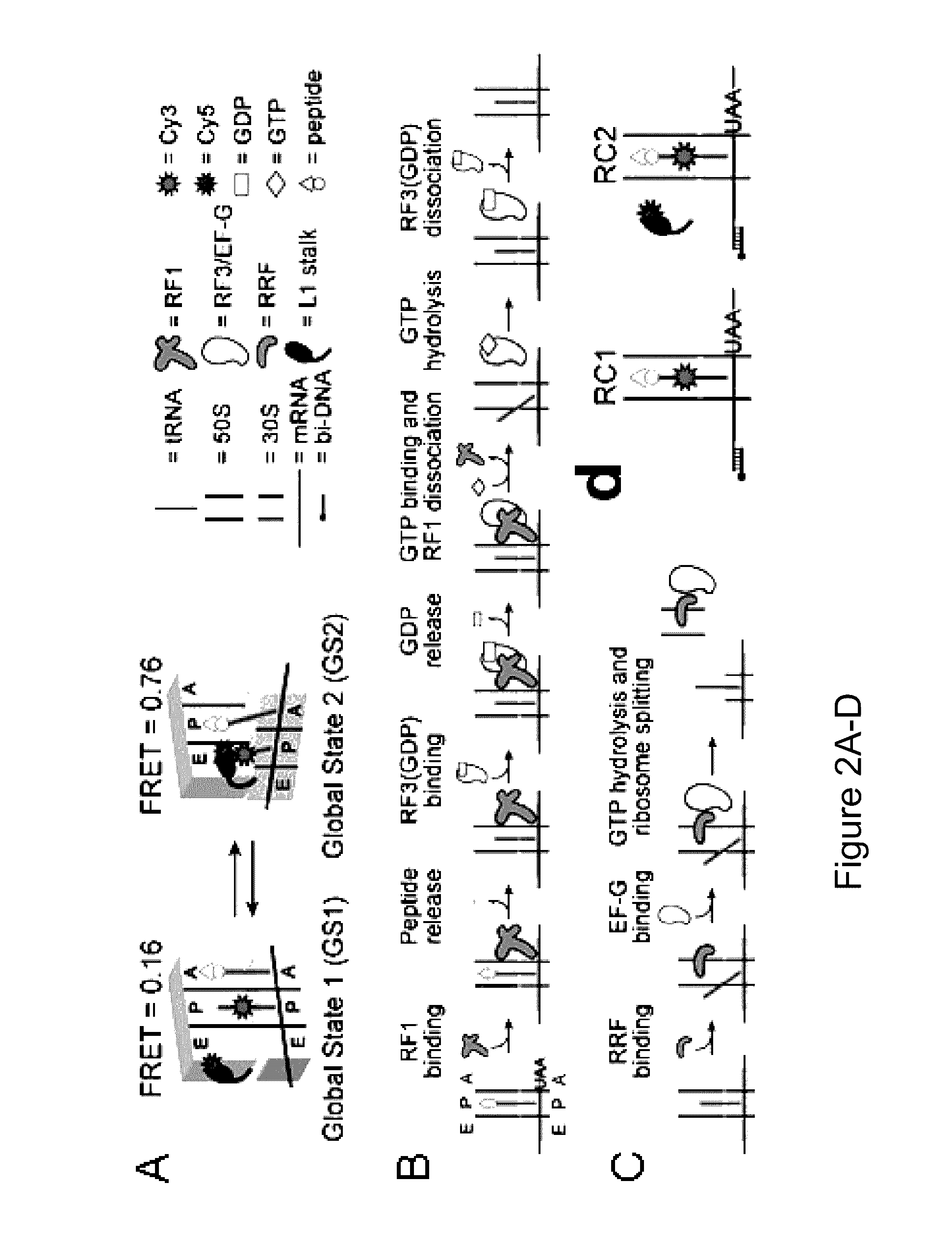Fluorescence-based approach to monitor release factor-catalyzed termination of protein synthesis
a technology of release factor and protein synthesis, which is applied in the direction of immunoglobulins, instruments, peptides, etc., can solve the problems of clinically significant side effects and limitations of small molecule based therapeutic efforts to inhibit termination events at premature stop codons, and achieve high fret efficiency and fluorescence resonance energy transfer efficiency.
- Summary
- Abstract
- Description
- Claims
- Application Information
AI Technical Summary
Benefits of technology
Problems solved by technology
Method used
Image
Examples
example 1
General Methods
[0171]Protocols describing (1) the Tris-Polymix buffer system, (2) the purification of ribosomes, tRNA synthetases, formylmethionyl-tRNA formyltransferase, and translation factors, (3) the specific fluorescent-labeling of tRNAPhe as well as purification of fluorescently-labeled tRNAs, (4) the aminoacylation of tRNAs, preparation of the 10-formyltetrahydroformate formyl group donor and formylation of Met-tRNAfMet, (5) the formation of EFTu(GTP)aa-tRNA complexes, and (6) the preparation and purification of ribosomal complexes initiated on chemically synthesized mRNAs harboring a 5′-biotin modification, (7) extract and analyze ribosomal proteins, (8) generate ribosomal protein deletion strains, (9) clone, mutagenize, overexpress, purify, and fluorescently label ribosomal proteins, and (10) reconstitute ribosomes bearing single fluorescently-labeled ribosomal proteins are previously published (Fei et al. 2008; Gonzalez et al. 2007; Blanchard et al. 2004a; Blanchard et al....
example 2
Cloning and Purification of Release and Ribosome Recycling Factors
[0172]Genes encoding RF1, RF3, and RRF from Escherichia coli C600 genomic DNA were cloned into the pProEx-HTb vector (Invitrogen), which contains an ampicillin-resistance marker, using KasI (5′) and KpnI (3′) restriction sites, which places the gene under Trc promoter control and appends an N-terminal hexahistidine affinity tag (SEQ ID NO: 9) and downstream TEV protease cleavage site. Enzymatic cleavage of the affinity tag leaves an extraneous GA dipeptide at the N terminus of each protein factor.
[0173]The PrmC gene encoding the RF1-modifying glutamine-N-5-methyltransferase was cloned from E. coli genomic DNA into the pET-26b(+) vector (Novagen), containing a kanamycin-resistance marker and an IPTG-induced T7 promoter, using NdeI (5′) and HindIII (3′) restriction sites. Appendage of the optional C-terminal hexahistidine affinity tag (SEQ ID NO: 9)was avoided by placing a stop codon at the C terminus of the gene. The R...
example 3
Preparation of IFs, EFs, tRNAs, mRNA and L1(Cy5) Ribosomes
[0176]Initiation and elongation factors were purified as previously described (Blanchard et al. 2004b). tRNAPhe (Sigma-Aldrich) was labeled with Cy3—NHS ester (GE Healthcare) at the naturally occurring acp3U modification at position 47, and purified using hydrophobic interaction chromatography (Blanchard et al. 2004b). tRNAfMet (MP Biomedicals), tRNAPhe, and (Cy3)tRNAPhe, and formylated Met-tRNAfMet was aminoacylated (Blanchard et al. 2004b). The mRNA used in this analysis is derived from the mRNA encoding gene product 32 from T4 bacteriophage. The sequence of this mRNA is:
[0177]
(SEQ ID NO: 5)GGCAACCUAAAACUUACACAGGGCCCUAAGGAAAUAAAAAUGUUUUAAUGUAAA(SEQ ID NO: 6)UCUACUGCUGAACUCGCUGCACAAAUGGCUAAACUGAAUGGCAAUUAAGGAUC,
where the nucleotides in bold are a 26 nucleotide spacer region containing an 18 nucleotide sequence (underlined in bold) to which a complementary 3′-biotinylated DNA oligonucleotide (IDT; TGTGTAAGTTTTAGGTTGATTTG-Biot...
PUM
| Property | Measurement | Unit |
|---|---|---|
| temperature | aaaaa | aaaaa |
| temperature | aaaaa | aaaaa |
| wavelength | aaaaa | aaaaa |
Abstract
Description
Claims
Application Information
 Login to View More
Login to View More - R&D
- Intellectual Property
- Life Sciences
- Materials
- Tech Scout
- Unparalleled Data Quality
- Higher Quality Content
- 60% Fewer Hallucinations
Browse by: Latest US Patents, China's latest patents, Technical Efficacy Thesaurus, Application Domain, Technology Topic, Popular Technical Reports.
© 2025 PatSnap. All rights reserved.Legal|Privacy policy|Modern Slavery Act Transparency Statement|Sitemap|About US| Contact US: help@patsnap.com



